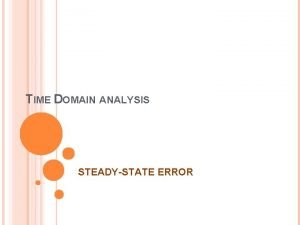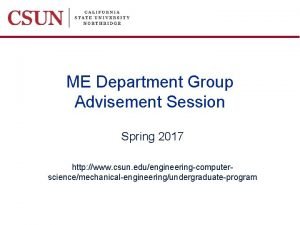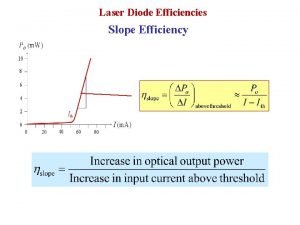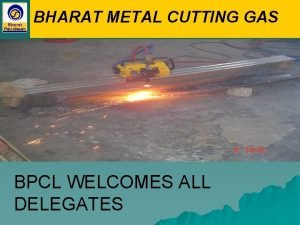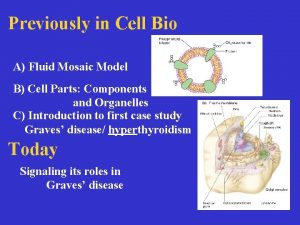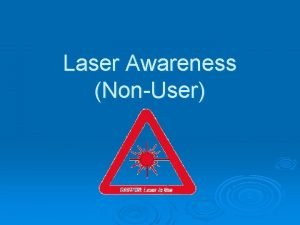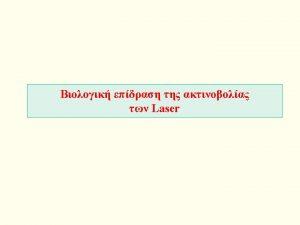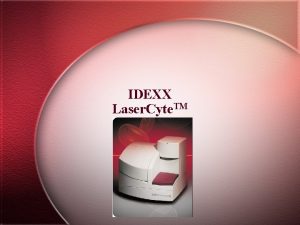SteadyState Laser Output SteadyState Laser Output Previously we










- Slides: 10

Steady-State Laser Output

Steady-State Laser Output Previously, we derived the relation: This relation can be solved numerically to obtain the output irradiance IL when knowing the input irradiance Io and the characteristics of the gain medium 0 , L and Is. This relation can also predict the steady-state or continuous wave (CW) output irradiance given: - The nature of the pump - gain medium - cavity

Steady-State Laser Output We will develop two expression for the CW output irradiance for the two cases: 1. Ring laser 2. Linear cavity laser

Steady-State Laser Output 1. Ring laser: • • The reflectance of the three mirrors M 1 , M 2 and M 3 are R 1 , R 2 and R 3. M 3 is the output mirror with a transmittance T 3. The gain medium is characterized by its saturation irradiance Is , length L and small-signal gain coefficient 0. We assume that laser action occurs only in the counterclockwise direction around the ring.

Steady-State Laser Output 1. Ring laser: • • • In steady-state, losses due to imperfect reflection and transmission at the mirrors must be, in each round-trip, offset by the increase in irradiance that results from interaction with the gain medium. Tracking the irradiance from the output end around the ring to the input ring leads to the relation: where S is the fraction of the irradiance that survives the trip around the cavity from the output to the input of the gain cell. S = R 1 R 2 R 3

Steady-State Laser Output 1. Ring laser: • We use the expression for I 0 In the relation: to give us the steady-state irradiance at the output end of the gain cell. The irradiance of the laser beam exiting the ring cavity is then:

Steady-State Laser Output 1. Ring laser: - - Larger irradiance occurs for gain media with larger saturation irradiance. But, Is is a property of the gain media and cannot be manipulated. I 0 ut can be increased by increasing the pump density Rp 2 since this increases 0. I 0 ut can be increased by decreasing the losses not associated with the laser output. 0 must exceed a threshold value th to avoid negative I 0 ut - th characterize the cavity losses. -

Steady-State Laser Output Example: A ring laser cavity system uses mirrors with reflectances R 1 = R 2 = 0. 99 and R 3= 0. 95. The transmittance at the output mirror is T 3 = 0. 04. The gain medium is a 10 cm long Nd: YAG crystal with a saturation irradiance of 2300 W/cm 2. The crystal is optically pumped at a rate that leads to a small-signal gain coefficient of 0 = 0. 05/cm. a. Find the threshold gain coefficient for this cavity. b. Find the irradiance of the laser field that exits this cavity. c. Assuming that the laser beam has cross sectional area A = 0. 1 cm 2 , find the output power of the laser. d. Assuming the overall efficiency of this laser system is 3%, find pump power required to operate this laser system.

Steady-State Laser Output 1. Two-mirror linear cavity: - T 2 is the transmittance of the laser cavity output mirror. R 1 and R 2 are the reflectances of the cavity mirrors. The gain cell is characterized by the length L, 0 and Is. The threshold value th for the two-mirror cavity is:

Steady-State Laser Output Example: Estimate the minimum length of a linear cavity with mirror reflectances R 1 = 0. 99 and R 2 = 0. 98 that can be used in a He-Ne laser system given a small-signal gain coefficient of 0. 001/cm.
